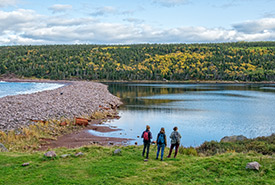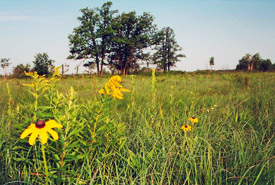CARE: What does impact look like?

Hikers at Freshwater Bay, NL (Photo by Dennis Minty)
We know there has never been a more important time for nature, nor a greater need for the Nature Conservancy of Canada’s (NCC’s) mission. The twin global crises of dramatic biodiversity loss and climate change will mark the decade through 2030. Nature conservation is an integral response to both.
Under the Convention for Biological Diversity, Canada has adopted ambitious targets to contribute to global efforts of addressing the twin crises. NCC recognizes that we have an essential role to play — for the sake of our communities, our country and our planet. By mobilizing Canadians, we will accelerate conservation for our country’s most important habitats — for biodiversity and climate resilience — using CARE.
The CARE principle — connected, adequate, representative and effective — is globally recognized as a guideline for ensuring the long-term conservation of natural areas.
Connected

Canada lynx (Photo by iStock)
Protected areas are connected so that plants, animals and natural systems can survive.
An important consideration in creating protected areas is ensuring that important places for biodiversity conservation are connected. This is important for species' movement between habitat patches, to ensure an exchange of genetic material between locations. It is also becoming increasingly important to adjust to the effects of climate change and give species the opportunity to move as climate conditions change.
Adequate

Cultus Creek, Darkwoods, British Columbia (Photo by Bruce Kirkby)
Protected areas include enough quality habitat to allow a diversity of plants, animals and natural systems to survive.
An important consideration in biodiversity conservation is whether an adequate amount of area or habitat has been secured for each feature or species of concern/interest. Some species need more habitat than others, and the goal is to protect an adequate amount of habitat for each species to survive and ideally thrive into the future.
Representative

Prairie grassland, Manitoba (Photo by NCC)
Protected areas cover the full range of biodiversity within a region.
To ensure the long-term survival of biodiversity, the ecological and evolutionary processes that sustain biodiversity must be maintained. A representative protected area system protects all parts of biodiversity in a region. This ranges from a species’ distinct population, to species groups, all the way to entire ecosystem types, such as tall grass prairie or northern peatlands. This ensures that all features of biodiversity are protected into the future.
Effective
Protected areas are established and managed effectively to ensure conservation objectives are met.
The efficiency principal of the CARE framework in systematic conservation planning is about finding good solutions in a cost-effective way, while making sure the solutions are realistic and acceptable to most stakeholders involved.


